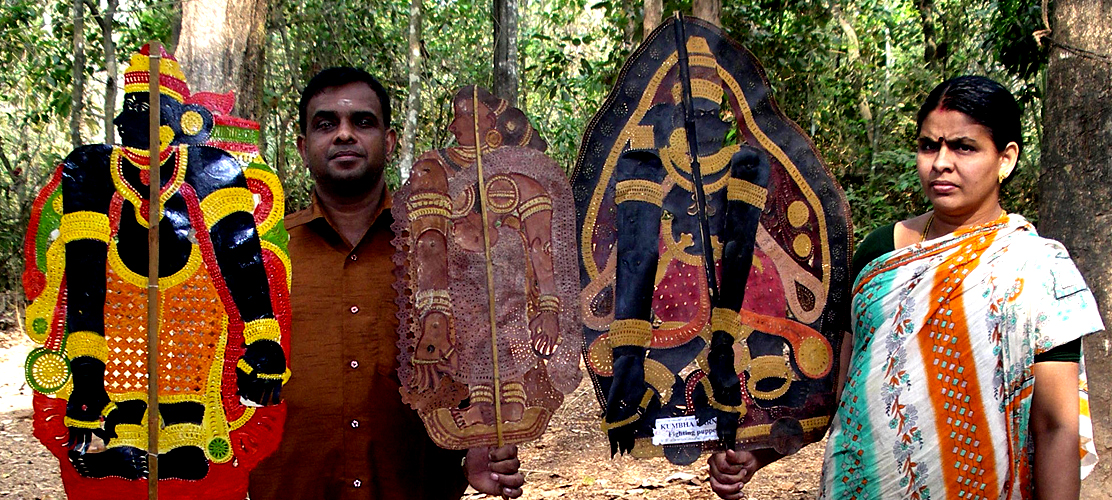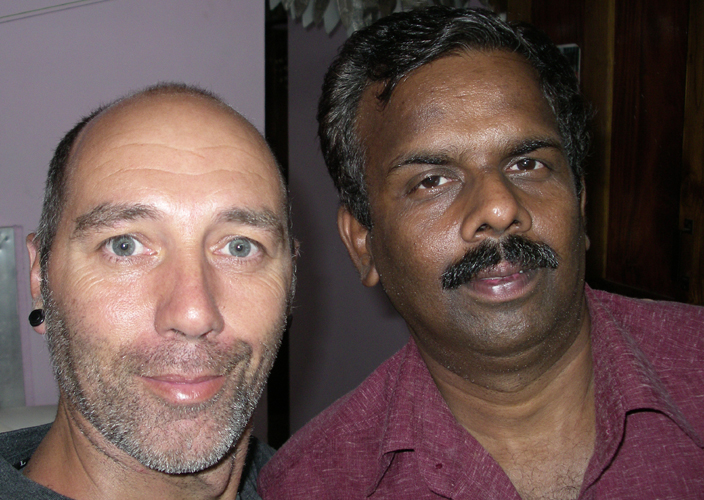


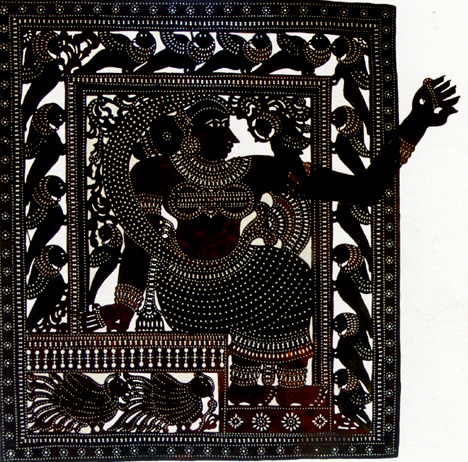
"Long ago there lived here a demon (Asura) called Darika who became a real threat to the gods and men. To kill this daemon Shiva created a goddess known Bhadrakali, responsible for the poisoning. Bhadrakali Darika killed during d a great fight but did not attend the victory and the triumph of Rama over the king of Lanka, Ravana. Bhadrakali was eternally unhappy "
Therefore, the story of Ramayana was chosen as the basis for Thol-Pavakoothu and played in the temples of Kali. We infer that this art is very old without being able to date it accurately. The story of Ramayana is extended to the anniversary of the coronation of Rama. It is represented in 21 scenes written especially for artists and played for 21 nights. This work, partly written in verse and prose is called Adal pattu. Adal means "representation" and Pattu "tell" the party to the Addal-called Pattu Koothu-kavikal.
The Adda pattu presented today included a large number of verses from Kamba-Ramayana, Tamil version of Ramayana written by poet Kambar. For some cons to have been modified for special performances. More artists have also added their own verses in Tamil and Sanskrit, to suit certain situations or contexts. The story and the verses are written on palm leaves, bound accordion and closed by a bamboo hedge. These messages are carefully kept in the abodes of puppeteers.
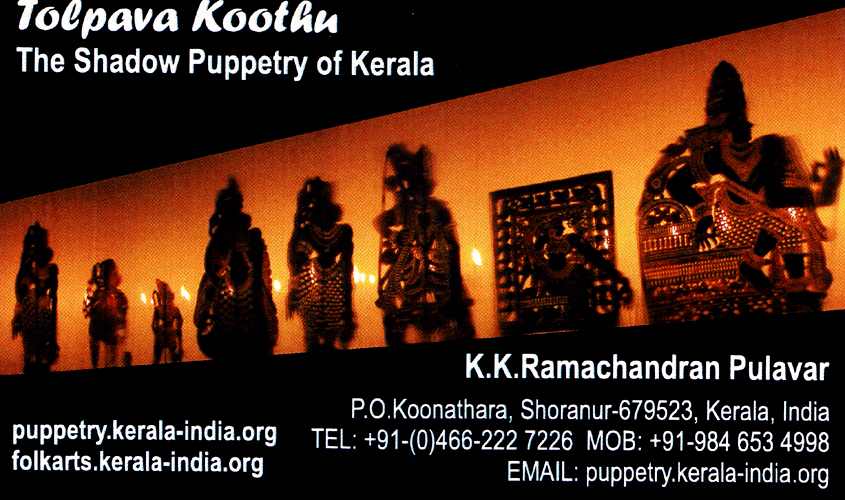
"The king of Lanka, Ravana, overwhelmed by the beauty of Sita, asks the devil Maritch turning into golden deer to attract Rama, a noble son of Raghu in the forest, far from his beloved. In this way the demon king could capture the beautiful Videhan "
It is natural that the deer skin was used and still today, to make the shadows of Thol-Pavakoothu. Factors shadows are convinced that the leather of this animal is sacred and generating predictions. When the skin is cleaned, dried and tanned to the consistency of a translucent parchment, form the desired character is drawn above. Then the skin is cut following its contours. The facial expressions, decorations, depictions of weapons, and costumes are chiseled, drilled with precision and confidence. More than a dozen different scissors are used for this delicate work. A hollow bamboo rod is attached vertically along the length of the figure, to prevent it not to bend or become damaged when it is pressed against the screen. The figures are color coded and used for their identification. They are painted with taste, refinement and natural colored pigments such as bark and leaves Kašava tree Neli. Every important character in history is represented in 3 different postures: sitting, walking and fighting. Normally only 1 hand puppet moves. It is set so that it can be moved and has a joint at the wrist, elbow and shoulder. By fighting against the figurines have 2 mobile hands. The reason is obvious, because to take a bow and arrow or a battle, the shade uses 2 hands.
They may also represent elephants, horses, monkeys, peacocks and other animals. They also describe natural scenes, such as trees, mountains, sea, or lake, but are always appropriately designed and offer more opportunities joints. An important feature is the shadow of Sri Rama and walking normally measuring 79 cm in height and 46 cm wide. The dimensions of Ravana fighter are 85 cm high and 68 cm wide. If it is cautiously row a figure can be conserved and used for over 100 years. For a complete 130 characters are needed.
To illustrate and interpret the deeper meaning of the verse, the puppeteers add explanations, dialogues, and stories, not contained in the library. They are transmitted orally from teacher to student. The interpretations and explanations of the artists are the foundations on which they demonstrate their talent, erudition and originality.
There are differences of opinions among experts, about the time when the poet lived Kambar. Some are in the ninth century, the other in the thirteenth century. The Ramayana of Kambar is composed of 6 chapters (Kanda-s) that call Balkandali, Ayodhyakanda, Aranyakanda, Kishkindhakanda, Sundarakanda and Yuddhakanda. Long before the Ramayana of Kambara arrives in Kerala, the Ramayana was told through the Thol-Pavakoothu in temples Bhadrakali which leads us to conclude that there was a form of Ramayana, specially written for Thol - Pavakoothu. This influence is very strong when the original was transformed by new worms. Experts believe that this change took place 350 years ago, has Puthur, where there lived a scholar named Chinna tampa Vadhyar belonging to the caste Valachetti. Apparently this man was the first to introduce to the Ramayana of Kambar in Addal Pattu-existent.
One day, Chinna who had great knowledge of the Ramayana, visited the bhraman neighbors to hear the chanting. But it was not accepted by the meeting because he belonged to a lower caste. Humiliated, he decided that the current Ramayana of Kambara is accessible to all men and all castes. It chooses a master-Thol Pahvakoothu which added several new worms that changed the very existence of Addal-Pattu. Chinna Tampa was responsible for the increased popularity of Thol-Pavakoothu. The artists are from castes and Vallachetti Nair. Kunchana Nambiar, one of the great Malayalam poets of the eighteenth century, refers to Thol-Pavakoothu with reverence, in his poem "Ghoshayatra" This statement shows how this art was popular in the eighteenth century.
As the context for the scenes, the artists provide explanations, information and comments that may last several hours on worms or couplets. The puppeteer who tells the story tends to move away voluntarily to introduce, with subtlety and relevance of topics of interest for spectators.


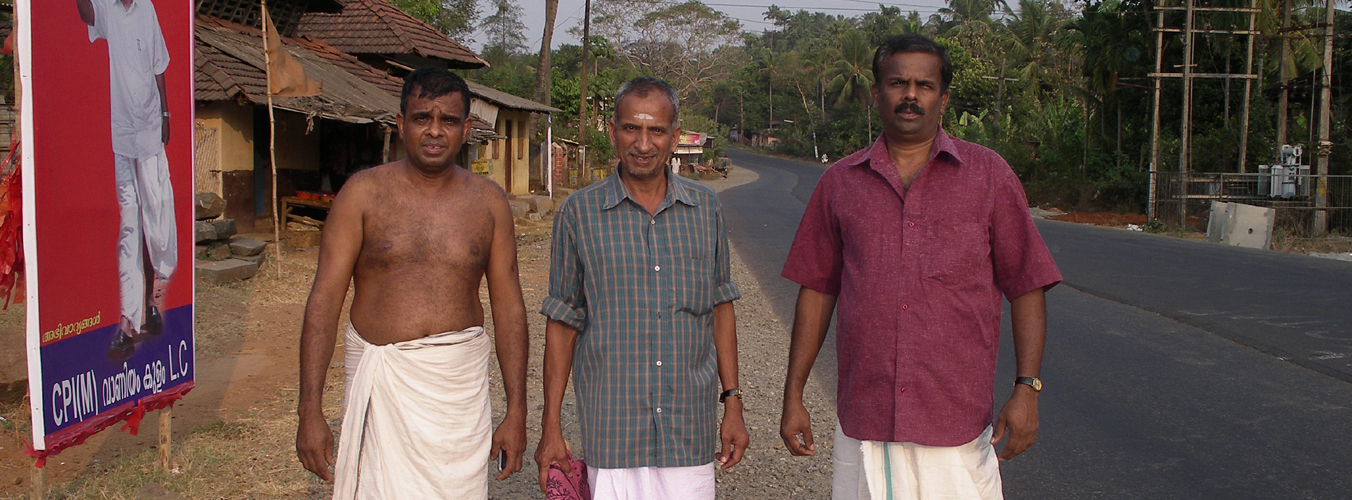
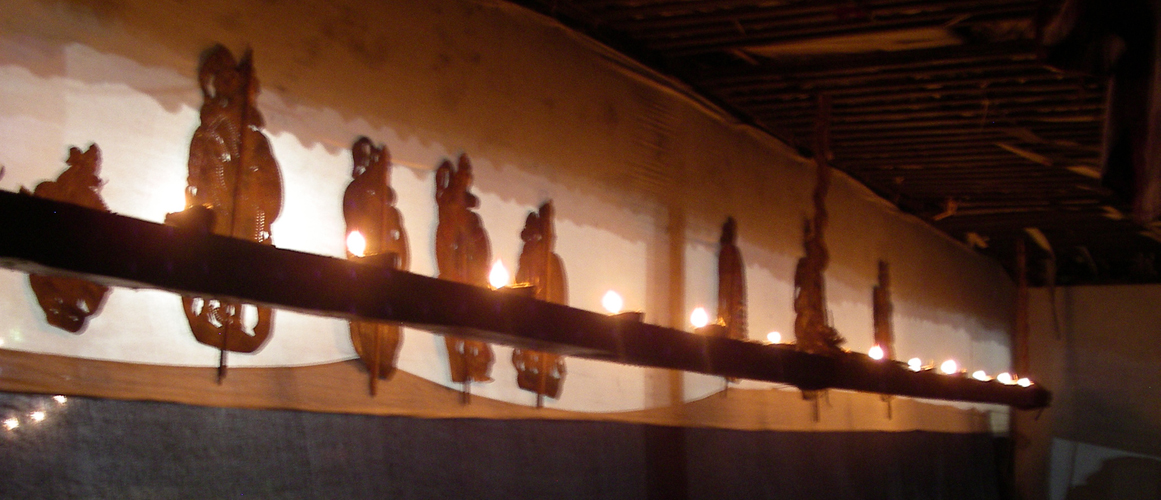


Lighting & Décor
Envelopes coconut broken into 2 identical parts are used as lamps. They are placed on the board equidistance from each other. Of coconut oil is poured into these half-spheres which dips a cotton wick. Normally, 21 lamps are used but on some occasions, additional effects of light are created. A powder called Telli, consisting of a gum crushed, dried, from a tree endemic to Kerala, is thrown on the flames to intensify the light. Torches were lit for special occasions. The front and back of the stage are decorated with coconut leaves and garlands of flowers. The master puppeteer "Madapulavar" oversees all these arrangements.
Permanent scenes are built within the walls of various temples. Called "Koothu-Madam" or home games they are positioned so they are faced with the image of the goddess of the temple. They are presented as a castelet theater or house closed on 3 sides with a roof. The fourth side is formed, along its entire length of a wall about 1.50m tall and retains a long opening to the edge of the roof. The dimensions of the home games of the Aryan Kavalappara Kavu temple, famous site for presenting this art reaches 11m43 long, 3m81 wide and 1m53 tall. It is said that formerly there were over 100 temples with Koothu-Madam. Currently it is 63 in the Palghat district and its environs. The front of the scene is obscured by a screen of white cloth called Ayapudava. The bottom is covered with a black cloth representing the underworld called Patala unlike the upper symbolizing the earth and the heavens. A long, narrow wooden board called Vilakkumadam is set at 1.30m tall, behind the curtain a few inches of it. This layer covers the entire length of the screen and it is this that the necessary light sources are arranged.

Manipulation of shadows
To place the figures on the length of the screen that measures more than 12m long, it takes no less than 5 artists for this work. In many cases, they run from one end to another of the curtain with their shadows in his hands. The 3 or 4 artists commissioned to chant verses and recite dialogues take their positions behind those who manipulate. This establishment is required because the game will continue throughout the night. It's very hard on artists who take their roles until daybreak. The puppet figure before her like a hawk, with one hand while he simultaneously manipulates the hand of the shadow with a rod he has in the other. The artist, around the wrists and bracelets made of bells and small cymbals that produce a sound synchronized with the handling. When a major character is killed or maimed, liquid red imitating the consistency of blood, is thrown on the screen to produce a vision bloody and realistic. Special techniques used in temple accentuate certain scenes like the one below.
"Indrajit sent the divine serpent-arrow Nagapasha which plunged Lakshmana Sugriwa and others in a deep sleep. That's when the mythical Garuda bird arrived to help"
A wooden puppet Garuda representative was suspended to son, operated by a system of pulleys and cables are stretched and manipulated to the full length of the screen. This gives the audience stunned, like seeing flying puppetry.
Proceedings of the representation
Representations of Thol-Pavakoothu are conducted through annual festivals held in temples where the faithful pay for the realization of their wishes. The representation of the entire Ramayana lasts 21 nights, but there are shorter versions with 14 or 7 nights. The days when performances are held for the Pooja ceremony, offerings in honor of the goddess were made just after sunset. We begin by lighting an oil lamp in bronze called "Tookuvilakku" to illuminate the icon of the goddess is then transported to the home game to be suspended above the musicians. The next step is the installation of the screen. This ritual is called Koora-Iduki. Koora means curtain or screen and Iduki, put in place. Then the front of the small castle is decorated. Around 21 pm a large gathering invested the temple to witness this magical night. The Velichappadu (the oracle of the goddess blessed the crowd and communicate their orders in his name) wears a red silk scarf around the neck, ankle bracelets sound and a sword in hand, with which he crowned the temple . Then he goes to the gambling house to bless the manipulators and musicians. The ceremony Velichippaddu from temple to Koothu Madam, may be as great in the temple Payilur to Kollengode where a distance of 201 meters between them. The oracle is then accompanied by 3 elephants painted and beautifully decorated, music and smoke. After the blessing of the artists, the music begins, followed by the ritual called Kalarichindu where puppeteers sing a hymn to invoke the benevolence of Ganapati, Saraswati, Mamavishnu and other gods and goddesses. Then Madapulavar beni's home game with a special called Ranga Pooja, Pooja, which aims to ensure the success of the performance. After this the figure representing Ganapati is placed behind the screen and the artists sing hymns to invoke his blessing.
Then the shadows of some bhraman are shown before the curtain. These figurines, called Patta-Pavakal or "dolls bhraman" are the protectors "Sutradhar-s" shadows. They are known and called by their names: Mallika Pattar, Somasu Pattar, Mootha Pattar and Gangayadi Pattar. The master puppeteer often converse with their figures.
Here is an example of a conversation:
Madapulavar: Oh! Mallika Pattar,
when are you coming?
Mallika Pattar: Yes I have, I just
Madapulavar: Oh! Somasu, do not you come?
Somasu Pattar: Yes I am here I come
Madapulavar: Oh! Mootha Pattar, did you get?
Mootha Pattar: Yes I am, I am here
Madapulavar: Does Gangayadi is there?
Gangayadi Pattar I got there, I'm here now
All bhraman all: Hari, Hari, Govinda fact that Sri Rama is victorious. If
Sri Rama is victorious and prosperous, we want happiness and prosperity.
Then the bhraman sing in praise of Mahavishnu. Suit oblations and sacrifices
to the gods for the welfare of mankind. The next task is the greeting to the
teachers who were trained artists Thol-Pavakoothu. But these great scholars
belonging to lower castes and the belief that he is unclean to bhraman puppets
of their obedience. Thus there remains only Madapulavar, to remove the figurines
bhraman screen. Now the puppeteers practiced the ceremony of the Guru-Vandanam
which once completed will reappear bhraman shadows. It has now addressed the
audience:
"Look at the beautiful dance of the peacock with its feathers spread. The wild cock also tries to imitate. Our attempts to perform before a distinguished audience can appear ridiculous and futile. So we humbly ask the audience learned to forgive us for our inaccuracies'
Then they reveal the unfolding
of history which we will now be reported. Comes the moment of ritual called
"Sadya-Vazhthal" Sadya means Vazhthal banquet and praise. He invokes
the blessings of Sri Rama and Bhagvat and thanked members of the house where
the meals of the day artists are preserved. Artists praise the feast that
the family prepares for them, listing all the food component meal. When these
ritualistic ceremonies are completed representation Thol-Pavakoothu can begin.
During the performance at specific times in history, devotees offer money,
coconuts, garlands of flowers in shades of exhibitors. Similarly, a special
offering is made to the deity of the temple to promote fertility, marriage
and good harvests. Other positive events are celebrated by running the dance
Devastri-s "celestial women, punctuated by prayers for prosperity puppeteer
donor's offerings.
The 21st day after the game ends with the death of Ravana. The screen is removed
and sent for cleaning because it will serve one last time for the stage called
Sri Rama Pattabhisheka or "the coronation of Rama" and concluded
the series. Then the screen is removed and the Madapulavar tear into parts
for distribution to each artist because it is believed that the curtain is
never used. The season of performances Thol-Pavakoothu extends from January
to May Villagers call the puppeteers Pulavar-s or "scholars" They
are respected for their art but also because they are good tips for resolving
problems or conflicts. They are hosts of choice for area families who sometimes
take the responsibility to support the show each day.
During a performance-Pavakoothu Thol, reciting poetry and prose style and follow a particular color. For singing to no music itself, the tone of voice changes depending on the context and characters. When an artist recites a verse, the others produce a sound harmonic "Aaa" which, combined with the rhythm produces a sort of musical effect. The 2 instruments that accompany the stories are a drum (Ezhupara) with a wooden body, closed at the ends with calf leather and metal cymbals. To enhance dramatic effects, a gong, a flute, and conch are added in some special occasions. For example during the battle between Bali and Sugriwa the 2 protagonists and gnash teeth chattering, uproot trees, struggling with their trunks and rocks on howl as bloodthirsty warriors. Artists then add syllables and sounds clear (Vaithari-s) appropriate to the battle scenes and narrate the dialogues fighters. When these events are complete artists to re-tune with the pace and tone of origin.
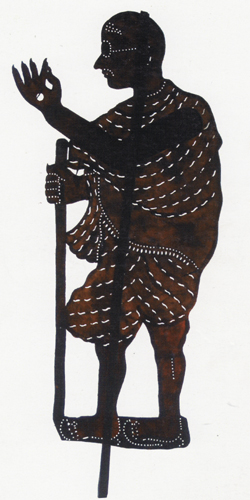
Formerly the puppeteers do not consider their art as a source of income. They owned a farm and the land acquired for the main livelihood. They trained in handling during the intervals when they were not working on the farm. They took part in performances of devotion to their deities, and to earn an honorable place in society. The donation offered by the temple is small but being honest they believed that their performances could make a cultural prosperity and encourage the people to witness their art.
Now, all these data have undergone
a radical change. Most of the artists participating in this art form are poor
and live in appalling situations. They never stay long at home as income caused
by the performances are too thin to support their families. In 1990 an artist
could hope to receive 15 rupees (about 3 dollars) at most. Moreover, the advent
of television and film eventually decline to their art in the life of Kerala.
A long period of training is required to train an artist to the age of 7 years
will begin to recite verses, learn by heart and soak manufacturing techniques
and manipulation of shadows. For some families, Thol-Pavakoothu is a strong
traditional heritage. A family in the village of Koonathara near Shooranur
can be proud of 4 generations of puppeteers. These members, true luminaries
in this area are: K.K Ramachandra, Viswanatha and Lakshmana Pulavar. The leader
of this family name Krishnankutty Pulavar but he unfortunately died in 2000.
A Mathur, Kuthanur, Pudusseri and Kayiliyad there are some families with a
strong tradition of showmen shadows.
The young generation of artists is not interested in this art form. In 1990
there were only 30 artists Thol-Pavakoothu in Kerala. Confined in temples
for offerings is now welcome to the outside by the Kerala and other Indian
states. In 1978 the national festival of shadow theater, organized by the
Sangeet Natak Academy in Bangalore calls for giving national status to Thol-Pavakoothu.
In 1979 a company was selected to give representation to the International
Puppet Festival in Moscow.
In August 1987 the troupe, led by master Krishnankutty Pulavar and puppeteer
G. Come, give performances at the festival "events Indian Sweden"
After Sweden, the troupe traveled to Greece on the island of Hydra to perform
in a festival run by the famous artist Michael Meschke. Since then, this art
is protected and developed by G. Venu, director and founder of the center
Natana Kairali, real laboratory research, protections for all the arts of
Kerala.
